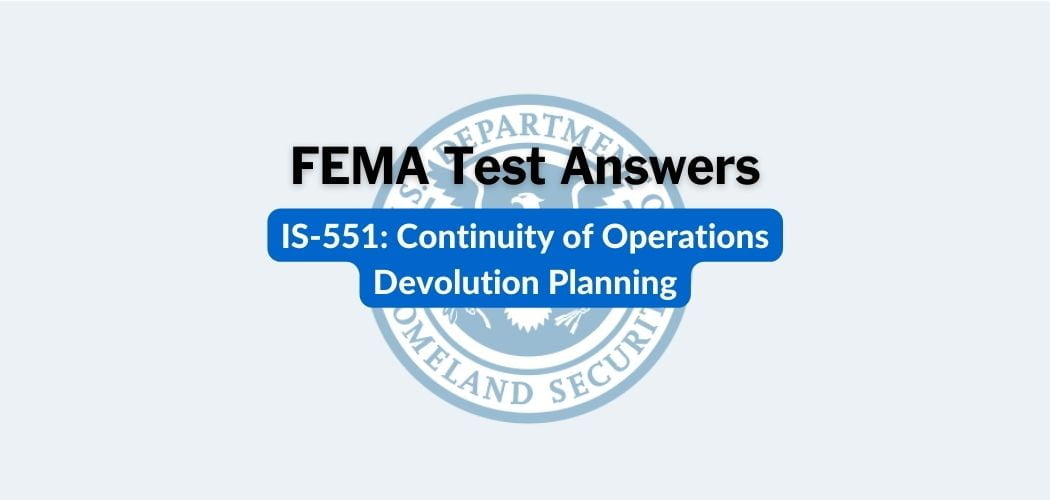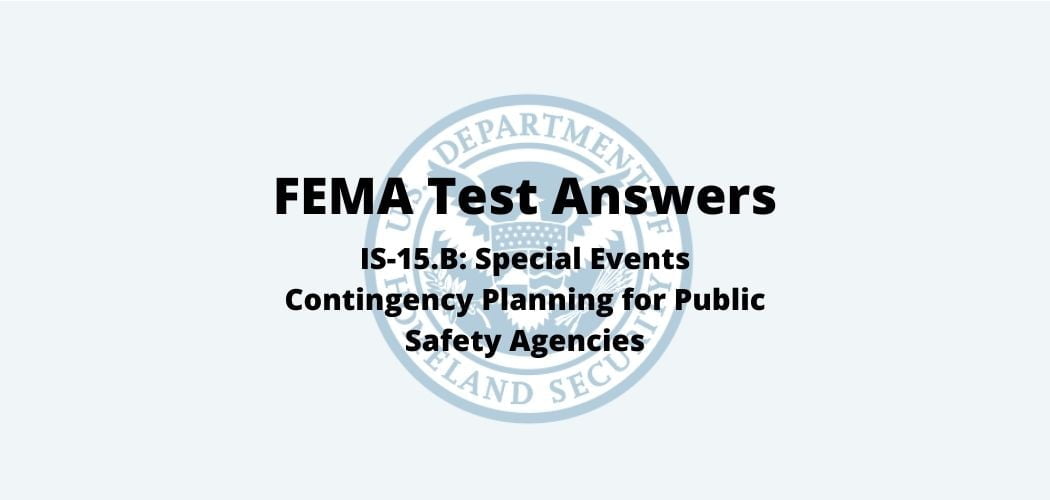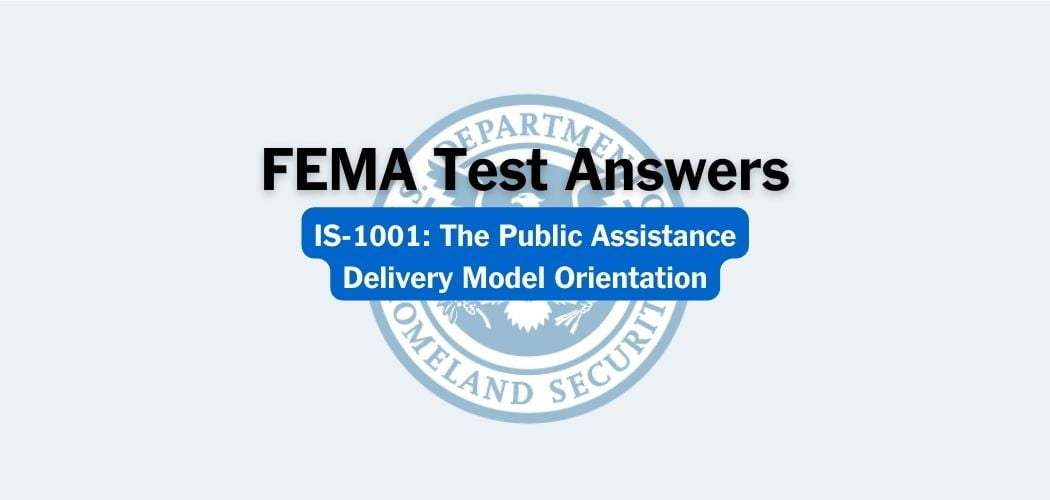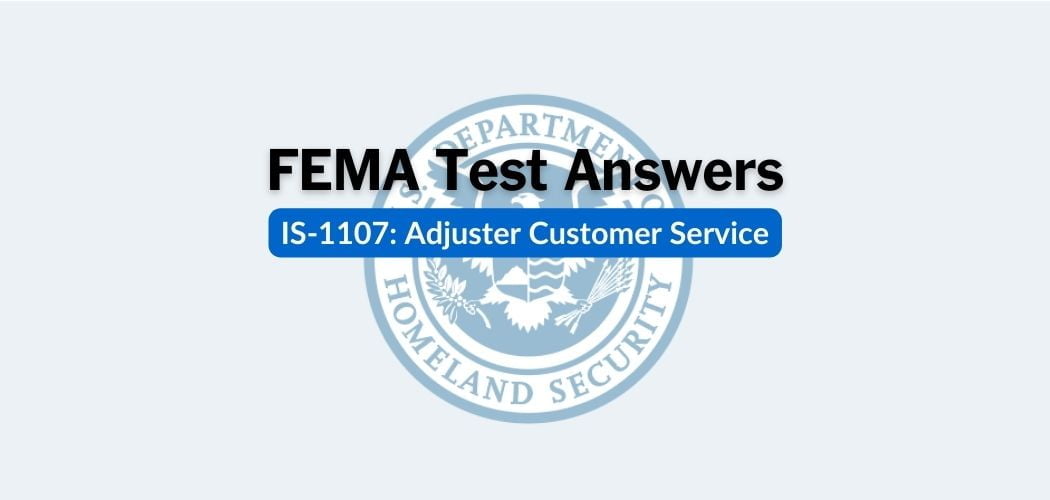Overview: The FEMA IS-700.B course was published on 6/25/2018 to provide an overview of the National Incident Management System (NIMS). Learners will gain a basic understanding of NIMS concepts, principles, and components.
Primary audience: The FEMA IS-700.B course is intended for a wide audience of personnel which includes government executives, private-sector and nongovernmental organization (NGO) leaders, emergency management practitioners, senior elected and appointed leaders, such as Federal department or agency heads, State Governors, mayors, tribal leaders, and city or county officials and other individuals with emergency management responsibilities including prevention, protection, response, recovery and mitigation.
FEMA IS-700.B test answers
Each time this test is loaded, you will receive a unique set of questions and answers. The test questions are scrambled to protect the integrity of the exam.
Question 1. Establishing mutual aid agreements to obtain resources from neighboring jurisdictions is an example of which resource management activity?
A. Planning for Resources✅
B. Qualifying, certifying, and credentialing personnel
C. Acquiring, storing, and inventorying resources
D. Identifying and Typing Resources
Question 2. Emergency Management Assistance Compact (EMAC) is a state-to-state system for sharing resources during an emergency or disaster.
A. TRUE✅
B. FALSE
Question 3. Which of the following is an EOC function?
A. Coordinating plans and determining resource needs
B. Collecting, analyzing, and sharing information
C. Providing coordination and policy direction
D. All of the above✅
Question 4. Which EOC configuration aligns with the on-scene incident organization?
A. Departmental Structure
B. Incident Support Model (ISM) structure
C. Strategic Joint Command Structure
D. ICS or ICS-like EOC structure✅
Question 5. Which resource management task establishes and maintains the readiness of resources and ensures providers are paid in a timely manner?
A. Mobilize
B. Order and Acquire
C. Track and Report
D. Reimburse and Restock✅
Question 6. Which NIMS Management Characteristic refers to the number of subordinates that directly report to a supervisor?
A. Manageable Span of Control✅
B. Management by Objectives
C. Chain of Command and Unity of Command
D. Modular Organization
Question 7. Which NIMS structure makes cooperative multi-agency decisions?
A. Emergency Operations Center (EOC)
B. Joint Information System (JIS)
C. Incident Command System
D. MAC Groups✅
Question 8. Which NIMS Management Characteristic helps to eliminate confusion caused by conflicting instructions?
A. Information and Intelligence Management
B. Accountability
C. Management by Objectives
D. Chain of Command and Unity of Command✅
Question 9. Which NIMS Management Characteristic includes developing and issuing assignments, plans, procedures, and protocols to accomplish tasks?
A. Manageable Span of Control
B. Management by Objectives✅
C. Comprehensive Resource Management
D. Modular Organization
Question 10. Regarding resource typing, which of the following characteristics are typically used to categorize resources?
A. Number available
B. Color
C. Location
D. Capability✅
Question 11. Which resource management activity identifies and verifies that personnel is qualified for a particular position?
A. Credentialing✅
B. Certification
C. Planning
D. Qualifying
Question 12. The _________ is a central location that houses Joint Information System (JIS) operations and where public information staff performs public affairs functions.
A. Incident Command Post
B. Emergency Operations Center (EOC)
C. MAC Group
D. Joint Information Center (JIC)✅
Question 13. Using social media to support activities such as producing maps and incident visualizations is an example of which communications standard?
A. Common Terminology, Plain Language, and Compatibility
B. Technology Use and Procedures✅
C. Information Security/Operational Security
D. None of the Above
Question 14. Which type of ICS facility is used to temporarily position and account for personnel, supplies, and equipment awaiting assignment?
A. Staging Area✅
B. Camp
C. Incident Command Post
D. Incident Base
Question 15. When only certain EOC team members or organizations are activated to monitor a credible threat, which Activation Level has been implemented?
A. Level 1 – Full Activation
B. Level 2 – Enhanced Steady-State✅
C. Level 3 – Normal Operations/Steady-State
D. Level 4 – No EOC is required
Question 16. Full activation of an EOC can include personnel from assisting agencies.
A. TRUE✅
B. FALSE
Question 17. Incident information is used across ICS, EOCs, MAC Groups, and JIS to aid in planning, determine incident costs, and identify safety issues.
A. TRUE✅
B. FALSE
Question 18. Which communications management practice includes specifying all of the communications systems and platforms that parties will use to share information?
A. Agreements✅
B. Policy and Planning
C. Standardized Communication Types
D. Equipment Standards
Question 19. Which resource management task determines the type, quantity, receiving location, and users of resources?
A. Order and Acquire
B. Identify Requirements✅
C. Mobilize
D. Track and Report
Question 20. ICS provides a standardized approach to the command, control, and coordination of _______ emergency personnel.
A. On-scene✅
B. Off-site
C. non-activated
D. EOC
Question 21. The ‘capacity for emergency management and response personnel to interact and work well together‘ describes which of the key communications and information systems principles?
A. Resilience and Redundancy
B. Interoperability✅
C. Security
D. Reliability, Scalability, and Portability
Question 22. Which organizations should be involved in communications planning?
A. Planning Section✅
B. Area Command
C. All Stakeholders
D. MAC Groups
Question 23. The Incident Action Plan is prepared by General Staff from which section?
A. Logistics
B. Planning✅
C. Finance/Administration
D. Operations
Question 24. The _______ are incident management personnel that the Incident Commander or Unified Command assigns to directly support the command function.
A. Task Force Leaders
B. Strike Team Leaders
C. Command Staff✅
D. General Staff
Question 25. Which NIMS structure develops, recommends, and executes public information plans and strategies?
A. Emergency Operations Center (EOC)
B. Joint Information System (JIS)
C. Incident Command System
D. MAC Groups✅
Question 26. In NIMS, when do managers plan and prepare for the demobilization process?
A. At the same time they begin mobilizing resources.
B. At the end of the incident.
C. During recovery.
D. When transitioning between operational periods.✅
Question 27. In NIMS, resource inventorying refers to preparedness activities conducted _________ (of) incident response.
A. with
B. instead
C. outside✅
D. during
Question 28. The jurisdiction receiving mutual aid can _______ resources if they do not meet its needs.
A. Disregard
B. Decline✅
C. Store
D. Redirect
Other popular FEMA test answers
- IS-005: An Introduction to Hazardous Materials
- IS-010: Animals in Disasters: Awareness and Preparedness
- IS-100: Incident Command System (ICS), An Introduction
- IS-200: Incident Command System (ICS), Basic Initial Response
- IS-120: An Introduction to Exercises
- IS-230: Fundamentals of Emergency Management
- IS-235: Emergency Planning
- IS-244: Developing and Managing Volunteers
- IS-363: Introduction to Emergency Management for Higher Education
- IS-906: Workplace Security Awareness
- IS-907: Active Shooter: What You Can Do
- IS-909: Community Preparedness: Implementing Simple Activities for Everyone



